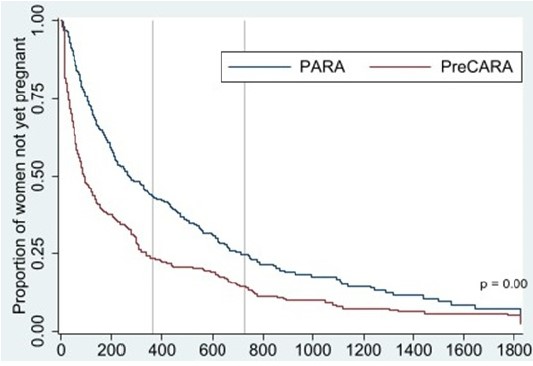Session Information
Date: Sunday, November 17, 2024
Title: Plenary II
Session Type: Plenary Session
Session Time: 9:00AM-10:30AM
Background/Purpose: Time to conception, known as time to pregnancy (TTP), is prolonged in women diagnosed with RA. High rates of infertility, defined as the inability to conceive within a one-year timeframe, were observed in female patients diagnosed with RA. RA-related factors that influence TTP were previously studied in the Pregnancy-induced Amelioration of RA (PARA) cohort. Those factors include high disease activity, daily nonsteroidal anti-inflammatory drug (NSAID) use and daily prednisone intake exceeding 7.5 mg. In the Preconception Counseling in Active RA (PreCARA) study, women who wish to conceive were followed in a clinical pathway with counseling and treatment according to a treat-to-target (T2T) approach, aimed at remission, but avoiding the use of NSAIDs and high dose prednisone. To achieve this, sulfasalazine and hydroxychloroquine were prescribed and if needed, TNF-inhibitors (TNFi) or low dose prednisone was added.
The aim of current study is to investigate whether the implementation of a T2T strategy, including TNFi use, in women with rheumatoid arthritis (RA) in the PreCARA cohort is associated with a shorter TTP compared to the historical PARA cohort.
Methods: In both cohorts, women were included before conception or during the first trimester of pregnancy. TTP was computed by measuring the interval between unprotected sexual intercourse and the onset of the last menstrual period. Differences in TTP were studied using Kaplan-Meier curves.
Results: 215 patients were included in the PreCARA study, while the former PARA study included 245 patients. The median disease activity was DAS28CRP(3) 2.33 in PreCARA patients during the preconception period, compared to DAS28 of 3.84 in PARA patients. In the PreCARA study, 3% of the patients did not take any medication during the preconception period, compared to 36% in the PARA study. During the preconception period, NSAIDs use was observed in 13% of PreCARA patients and 24% of PreCARA patients. In the PreCARA study, 23 of 96 (23%) patients that used prednisone, took daily doses over 7.5 mg, compared to 41 out of 85 (48%) PARA patients. In the PreCARA study, 53% of the patients used TNFi during the preconception period. In the PARA study, only 9 patients (3%) used TNFi. In the PreCARA study, the median TTP is 84 days in patients who got pregnant, in contrast to 196 days observed in the PARA study (Figure 1). TTP exceeded 12 months in 23% of PreCARA patients compared to 42% in the PARA patients.
Conclusion: TTP was shorter in PreCARA patients compared to PARA patients. This indicates that fertility is increased in women with RA when treated according to a T2T strategy, whilst avoiding NSAIDs and high doses prednisone.
women not yet pregnant.
To cite this abstract in AMA style:
Quaack C, Röder E, Wintjes H, van Steensel-Boon A, Mulders A, Kranenburg-van Koppen L, Dolhain r. Improved Fertility in Women with Rheumatoid Arthritis and a Wish to Conceive When Treated According to a Treat-to-target Approach Aimed at Remission [abstract]. Arthritis Rheumatol. 2024; 76 (suppl 9). https://acrabstracts.org/abstract/improved-fertility-in-women-with-rheumatoid-arthritis-and-a-wish-to-conceive-when-treated-according-to-a-treat-to-target-approach-aimed-at-remission/. Accessed .« Back to ACR Convergence 2024
ACR Meeting Abstracts - https://acrabstracts.org/abstract/improved-fertility-in-women-with-rheumatoid-arthritis-and-a-wish-to-conceive-when-treated-according-to-a-treat-to-target-approach-aimed-at-remission/


